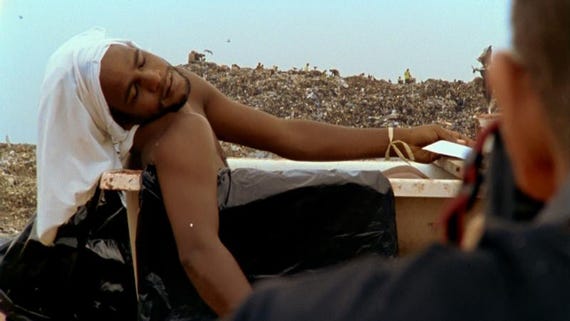April 8, 2011
A while back we mentioned the Oscar-nominated documentary "Waste Land," which follows artist Vik Muniz as he attempts, through art, to improve the lives of the scavengers (known as "catadores") living in the world's largest landfill, Jardim Gramacho in Rio de Janeiro. You can find our review of the film here. We also had the opportunity to discuss the film with director Lucy Walker, which you can read below.
You can see the film yourself when it premieres on the PBS anthology series Independent Lens on Tuesday, April 19. Check your local listings.
WASTE LAND Official Trailer from Almega Projects on Vimeo.
What first drew you to this story?
I met the artist Vik Muniz and we talked together about how we might make a film together, and cooked it up that way. There was no "story" there before; It really came out of our mutual respect and desire to collaborate.
What was it like shooting in Jardim Gramacho and what did you do to prepare for filming in a landfill?
When I went to a travel clinic and asked which vaccinations and medications I'd need to spend some time in a garbage dump in Rio de Janeiro, they gave me everything they had!! Then when I got to Rio I went to visit the landfill before we started filming there, to figure out what crew and equipment we'd need and how to shoot the first time that Vik arrives there. I had visited a landfill before in New York, so I knew you needed to be very mindful of getting dirt on your skin, clothes, and equipment.
What were your first impressions of the site and the people living upon it?
The very first day that I visited I met many of the people who wound up being in the finished film, particularly Valter, who passed away when we were making the film but who was the heart and soul of the place. He had a rhyme to help anyone through a discouraging moment. His extremely strong moral courage and his belief in the value of himself, his fellow catadores (pickers), and the work that they did were a true inspiration and it shone through in every moment with him.
How long was the shoot and how much total footage did you end up with?
The shoot was spread out over about two and a half years, and we wound up with about 200 hours of footage.
What surprised you most about the lives and work of the catadores?
Oh, well please see the movie! It's all in there!!
Are the catadores the only source of recycling in Rio de Janeiro?
Right now there are changes happening in Brazil regarding recycling. I hope that this will mean more respect and safer working conditions for the catadores and even higher rates of recycling. Actually, the catadores were very efficient at recycling. But it is very dangerous work and we want to see improvements in working conditions.
 What, to you, was the most compelling aspect of the art created by Vic and the catadores?
What, to you, was the most compelling aspect of the art created by Vic and the catadores?
Oh dear, I'm not sure I can pick one aspect! That's why there are lots of aspects in the film — from the beauty of Vik's artwork to the privilege of getting to see the portraits of the pickers made out of the same materials that they deal with every day, and to think about what their lives are like and reflect on what that teaches us... I like every aspect of the art!
To your knowledge, has the ACAMJG (the Association of Recycling Pickers of Jardim Gramacho) made contact with similar groups of pickers in other countries, like the zebaleen in Cairo or the cartoneros in Buenos Aires?
Yes, absolutely. ACAMJG is very involved with national and international groups of pickers.
What, to your knowledge, led to the imminent closing of Jardim Gramacho? How are the catadores preparing for this event?
The landfill is simply reaching capacity, and so nearing the end of its life receiving new garbage, as all landfills do. So it's a particularly important time for them.
What was the most discouraging thing you learned in making “Waste Land?” What was the most rewarding?
The most discouraging was the fact that the United States uses one third of the world’s resources, producing 30 percent of the world’s waste. While over 90 percent of our waste can be easily recycled or composted, only 34 percent of it currently is.
The most rewarding was meeting the catadores, who remind me of what's possible when you meet life's challenges with good attitudes and good humor and a determination to help one's community.
You May Also Like


